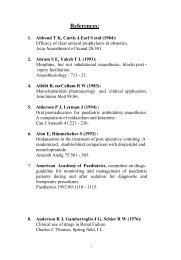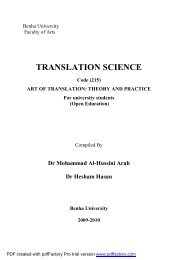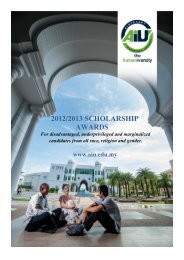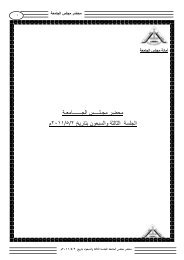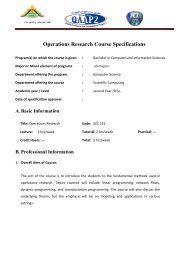Basem Ahmed Zoheir_Barramiya, OGR_2011.pdf
Basem Ahmed Zoheir_Barramiya, OGR_2011.pdf
Basem Ahmed Zoheir_Barramiya, OGR_2011.pdf
You also want an ePaper? Increase the reach of your titles
YUMPU automatically turns print PDFs into web optimized ePapers that Google loves.
(Germany). Additional information on fluid inclusions was obtained<br />
by Laser Raman Spectrometry (LRS) at the Section of Mineralogy and<br />
Mineral Resources, University of Geneva (Switzerland). A full suite of<br />
the electron probe microanalysis (EPMA) and fluid inclusions data is<br />
available on request from the corresponding author.<br />
Several sulfide grains have been analyzed for their major and some<br />
trace elements by a laser ablation inductively coupled plasma mass<br />
spectrometry (LA-ICP-MS) at The University of Erlangen (Germany).<br />
High precision spatially resolved analysis of δ 34 Sinsulfides has been<br />
accomplished using a laser ablation system linked with a multi-collector<br />
(MC)-ICP-MS at the Scottish Universities Environmental Research<br />
Centre (SUERC), UK.<br />
5. Ore mineralogy, paragenesis and arsenopyrite geothermometry<br />
5.1. Ore minerals<br />
Ore minerals disseminated in the quartz veins and adjacent<br />
wallrocks are mainly arsenopyrite, pyrite and trace amounts of<br />
chalcopyrite, sphalerite, tetrahedrite, galena, pyrrhotite, gersdorffite<br />
and gold. Partial to complete replacement of pyrite by marcasite is<br />
common. Other secondary phases include covellite and goethite.<br />
Sulfides generally make up less than 2% of the vein volume, but vary in<br />
abundance across the width of the vein. Arsenopyrite and pyrite occur<br />
as medium to fine-grained disseminated grains (tens of μms to 0.5 cm<br />
wide) throughout the veins, but also as clusters intergrown with<br />
chalcopyrite. Generally, these ore minerals are most abundant along<br />
the carbonaceous shear planes in the wallrocks or in domains rich in<br />
Cr-sericite (mariposite) and Mg–Fe-carbonate in the quartz veins.<br />
B. <strong>Zoheir</strong>, B. Lehmann / Ore Geology Reviews 39 (2011) 101–115<br />
Fig. 4. Features of the mineralized quartz veins at the <strong>Barramiya</strong> mine, (a) — Main Lode made up mainly of a voluminous early bluish quartz phase and a late fissure-filling milky<br />
quartz phase, (b) — Hand specimen of the NE–SW trending lodes with abundant Fe-carbonate and wallrock selvages, (c) — Sheeted quartz lode with abundant wallrock materials<br />
(view looking W), (d) — Markedly deformed, folded quartz–carbonate vein.<br />
Arsenopyrite is ubiquitous in quartz lodes and mineralized wallrock<br />
(Fig. 7a). It is generally optically homogeneous, but many of the large<br />
crystals (≥150 μm) display porous or inclusion-rich (sphalerite,<br />
chalcopyrite, gersdorffite and gold) cores and homogenous rims.<br />
Electron microprobe analysis of arsenopyrite revealed As-contents<br />
ranging from 40.1 to 43.6 wt.%, and occasionally elevated Ni, Ag, Sb,<br />
andAucontents(Table 1). Refractory gold in arsenopyrite, commonly<br />
at 100s ppm range and less frequently N1000 ppm Au, is evident by<br />
the electron microprobe and LA-ICP-MS analyses (n=102, range<br />
2193–116 ppm, average 667 ppm Au). Pyrite occurs as dispersed coarse<br />
hypidiomorphic or xenomorphic crystals and aggregates intergrown<br />
with arsenopyrite. Most of the large pyrite grains reveal local cracking<br />
and cataclasis or are pseudomorphed by marcasite, commonly where<br />
chalcopyrite and digenite are abundant (Fig. 7b). Traces of Ni (up to<br />
0.69 wt.%), As (up to 0.67 wt.%), Cu (up to 0.61 wt.%) and occasional<br />
hundreds of ppm Au are indicated by electron microprobe analysis of<br />
As-bearing pyrite (Table 1). Pyrrhotite occurs mainly as inclusion phases<br />
in pyrite and arsenopyrite, whereas free grains are relatively rare.<br />
Chalcopyrite occurs as anhedral crystals replacing pyrite and<br />
arsenopyrite and is intergrown with sphalerite and less common<br />
galena (Fig. 7c). Tetrahedrite occurs as subhedral crystals intergrown<br />
with chalcopyrite, and as minute inclusions in large chalcopyrite<br />
grains. Chemical data of tetrahedrite from the <strong>Barramiya</strong> deposit<br />
(Table 1) indicate a generally silver-rich, iron-poor composition<br />
(freibergite). Silver content in the analyzed grains varies from 29.45 to<br />
36.89 wt.%, and Sb content varies from 21.1 to 27 wt.%. Au content in<br />
tetrahedrite varies from traces up to N1000 ppm. Sphalerite and<br />
galena are commonly intergrown with chalcopyrite in comb quartz<br />
domains (Fig. 7d). Electron microprobe results on chalcopyrite and<br />
galena show that they are close to stoichiometric composition.<br />
105





